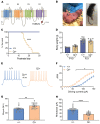Antisense oligonucleotide therapy reduces seizures and extends life span in an SCN2A gain-of-function epilepsy model
- PMID: 34850743
- PMCID: PMC8631599
- DOI: 10.1172/JCI152079
Antisense oligonucleotide therapy reduces seizures and extends life span in an SCN2A gain-of-function epilepsy model
Abstract
De novo variation in SCN2A can give rise to severe childhood disorders. Biophysical gain of function in SCN2A is seen in some patients with early seizure onset developmental and epileptic encephalopathy (DEE). In these cases, targeted reduction in SCN2A expression could substantially improve clinical outcomes. We tested this theory by central administration of a gapmer antisense oligonucleotide (ASO) targeting Scn2a mRNA in a mouse model of Scn2a early seizure onset DEE (Q/+ mice). Untreated Q/+ mice presented with spontaneous seizures at P1 and did not survive beyond P30. Administration of the ASO to Q/+ mice reduced spontaneous seizures and significantly extended life span. Across a range of behavioral tests, Scn2a ASO-treated Q/+ mice were largely indistinguishable from WT mice, suggesting treatment is well tolerated. A human SCN2A gapmer ASO could likewise impact the lives of patients with SCN2A gain-of-function DEE.
Keywords: Epilepsy; Neuroscience.
Figures







Comment in
-
All our knowledge begins with the antisenses.J Clin Invest. 2021 Dec 1;131(23):e155233. doi: 10.1172/JCI155233. J Clin Invest. 2021. PMID: 34850739 Free PMC article.
References
Publication types
MeSH terms
Substances
LinkOut - more resources
Full Text Sources
Other Literature Sources
Medical

